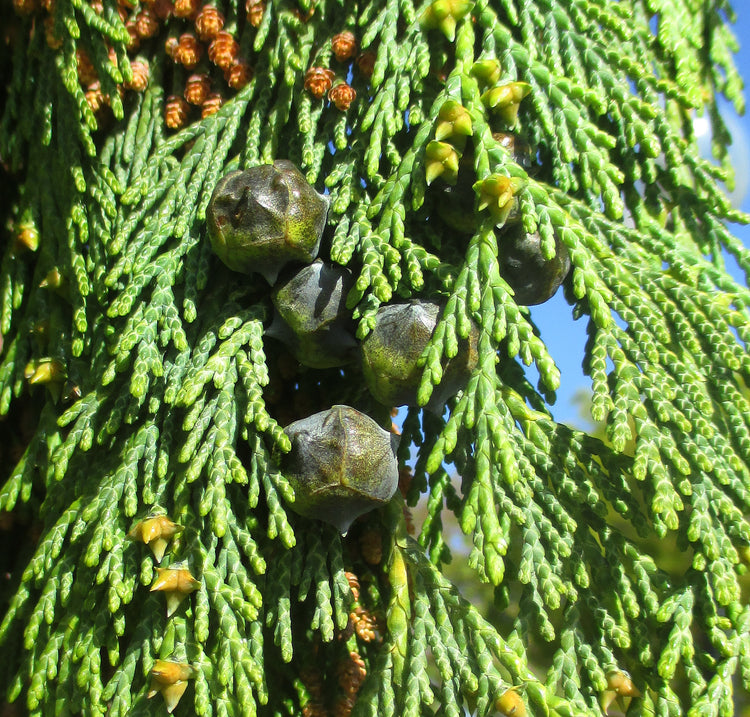Collection: Alaskan Yellow Cedar (Callitropsis nootkatensis)
Callitropsis nootkatensis, formerly known as Cupressus nootkatensis (syn. Xanthocyparis nootkatensis, Chamaecyparis nootkatensis), is a species of tree in the cypress family native to the coastal regions of northwestern North America. This species goes by many common names including: Nootka cypress, yellow cypress, Alaska cypress, Nootka cedar, yellow cedar, Alaska cedar, and Alaska yellow cedar. The specific epithet "nootkatensis" is derived from its discovery by Europeans on the lands of a First Nation of Canada, the Nuu-chah-nulth people of Vancouver Island, British Columbia, who were formerly referred to as the Nootka.
Callitropsis nootkatensis is an evergreen tree growing up to 40 meters (131 ft) tall, exceptionally 60 m (200 ft), with diameters up to 3.4 to 4 m (11 to 13 ft). The bark is thin, smooth and purplish when young, turning flaky and gray.[4] The branches are commonly pendulous, with foliage in flat sprays and dark green scale-leaves measuring 3–5 millimeters (1⁄8–3⁄16 in) long. The cones, maturing biannually, have 4 (occasionally 6) scales, and resemble the cones of Cupressus lusitanica (another species which can show foliage in flat sprays), except being somewhat smaller, typically 8–14 mm (5⁄16–9⁄16 in) in diameter;[4] each scale has a pointed triangular bract about 1.5–2 mm long, again similar to other Cupressus and unlike the crescent-shaped, non-pointed bract on the scales of Chamaecyparis cones. The winged seeds are small, thus dispersing at a close range; additionally, only a small percentage is viable.[4]
The Caren Range on the west coast of British Columbia is home to the oldest Nootka cypress specimens in the world, with one specimen found to be 1,834 years old;[5] some specimens may be over 3,000 years old.[6][7][8]
Callitropsis nootkatensis is one of the parents of the hybrid Leyland cypress; the other parent, Monterey cypress (Hesperocyparis macrocarpa), was also considered to be in the genus Cupressus, but in the North American Hesperocyparis clade, which has generally been found to be phylogenetically closer to C. nootkatensis than the Old World clade Cupressus sensu stricto.[9]
Distribution and habitat
The species grows in moist areas of coastal mountains of the Pacific Northwest, including those of the Cascades,[4] from the Kenai Peninsula in Alaska to the Klamath Mountains in northernmost California.[18][19] It can be found at elevations higher than those reached by Thuja plicata (western redcedar), sometimes in a krummholz form, and even occupying very rocky sites (near the California-Oregon border).[4] It can be found at elevations of 600 to 750 m (1,970 to 2,460 ft) in Southeast Alaska and between 750 and 2,000 m (2,460 and 6,560 ft) from coastal British Columbia into Oregon.[4] Isolated groves near Nelson, British Columbia, and John Day, Oregon, may be the descendants of local populations dating to the Last Glacial Period.[4]

-
Alaskan Yellow Cedar - End Grain - Reversible 20"L x 15"W x 2.25"T Cutting/Carving/Chopping/Serving Board
Regular price $199.00 USDRegular priceUnit price / per -
Checker Pattern - Alaskan Yellow Cedar & Honduras Mahogany - End Grain - Reversible 24"L x 18"W x 2.25"T Cutting/Carving/Chopping/Serving Board
Regular price $199.00 USDRegular priceUnit price / per -
Alaskan Yellow Cedar - End Grain - Reversible 24"L x 18"W x 2.25"T Cutting/Carving/Chopping/Serving Board
Regular price $199.00 USDRegular priceUnit price / per



